This reference has a simple Chirp function. Call it with the parameters and the time and it returns the signal value at that time. The w1, w2 are angular frequencies, so \$2\pi f_1\$, \$2\pi f_2\$, M is the chirp duration, A is the peak amplitude.
double Chirp(double w1, double w2, double A, double M, double time)
{
double res;
res=A*cos(w1*time+(w2-w1)*time*time/(2*M));
return res;
}
Edit: With 10-20MSps you'll likely be looking at dedicated hardware such as a DDS that supports a chirp function and has internal trig tables. You may be able to find a processor with a DMA function that would allow a pre-calculated table to be output to a DAC, but that would be a peripheral function.
